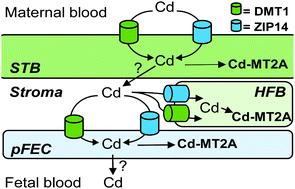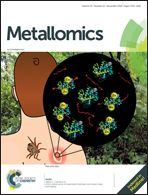人胎盘细胞系HTR-8/SVneo通过二价金属转运体DMT1和ZIP14†积累镉
IF 2.9
3区 生物学
Q3 BIOCHEMISTRY & MOLECULAR BIOLOGY
引用次数: 12
摘要
镉(Cd)是一种全球性的污染物,在胎盘中积累,可导致胎盘功能障碍。虽然铁转运体被认为参与胎盘镉的摄取,但仍不清楚哪些转运体实际上参与了这一过程。我们专门研究了三种铁转运蛋白在胎盘细胞系HTR-8/SVneo摄取Cd中的作用。为此,二价金属转运蛋白(DMT)1和ZRT/IRT样蛋白(ZIP)8和ZIP14下调,并分析细胞Cd水平的变化与对照组的关系。在DMT1-和zip14下调的细胞中,Cd含量降低了约60%,这清楚地表明,这两种蛋白对HTR-8/SVneo细胞中的Cd积累至关重要。使用一种经过验证的抗体,我们发现DMT1在滋养细胞和间质细胞中原位定位。我们进一步想要研究胎盘细胞如何应对Cd负载以及它们表达的金属硫蛋白(MT)亚型。Cd暴露的细胞以剂量依赖的方式积累Cd,并相应地上调MT2A(在5 μM CdCl2处理72小时后,诱导率高达15倍)。5 μM Cd暴露72小时,细胞数量减少至60%,MT2A耗尽(细胞数量减少至30%)加剧了这一效应,表明加性效应。总之,我们的数据表明,DMT1和ZIP14是人类胎盘细胞摄取镉所必需的,胎盘细胞通过上调MT2A来储存和解毒镉。胎盘中镉的储存减少了镉向胎儿的转运,但这可能损害胎盘功能和胎儿发育。本文章由计算机程序翻译,如有差异,请以英文原文为准。

Human placental cell line HTR-8/SVneo accumulates cadmium by divalent metal transporters DMT1 and ZIP14†
Cadmium (Cd) is a global pollutant that accumulates in the placenta and can cause placental dysfunction. Although iron transporters have been suggested to participate in placental Cd uptake, it is still unknown which transporters are actually involved in this process. We specifically aimed to study the role of three iron transporters in the uptake of Cd into the placental cell line HTR-8/SVneo. For this purpose, Divalent Metal Transporter (DMT)1 and ZRT/IRT like protein (ZIP)8 and ZIP14 were downregulated and changes in cellular Cd levels analysed in relation to controls. As clearly shown by the reduction of the Cd content by ∼60% in DMT1- and ZIP14-downregulated cells, the two proteins are essential for Cd accumulation in HTR-8/SVneo cells. Using a validated antibody, we show DMT1 to be localised in situ in trophoblast and stromal cells. We further wanted to investigate how placental cells cope with Cd loading and which metallothionein (MT) isoforms they express. Cd-exposed cells accumulate Cd in a dose-dependent manner and upregulate MT2A accordingly (up to 15-fold induction upon 5 μM CdCl2 treatment for 72 h). 5 μM Cd exposure for 72 h decreased cell number to 60%, an effect that was aggravated by MT2A depletion (cell number reduced to 30%) indicating additive effects. In conclusion, our data suggest that DMT1 and ZIP14 are required for Cd uptake into human placental cells that upregulate MT2A to store and detoxify the metal. Cd storage in the placenta reduces Cd transport to the fetus, which, however, could impair placental functions and fetal development.
求助全文
通过发布文献求助,成功后即可免费获取论文全文。
去求助
来源期刊

Metallomics
生物-生化与分子生物学
CiteScore
7.00
自引率
5.90%
发文量
87
审稿时长
1 months
期刊介绍:
Global approaches to metals in the biosciences
 求助内容:
求助内容: 应助结果提醒方式:
应助结果提醒方式:


